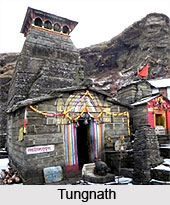 Panch Kedar refers to the five Hindu temples or holy places of the Shaivite sect dedicated to Lord Shiva. They are located in the Garhwal Himalayan region in Uttarakhand. They are the subject of many legends that directly link their creation to Pandavas, the heroes of the Hindu epic Mahabharata.
Panch Kedar refers to the five Hindu temples or holy places of the Shaivite sect dedicated to Lord Shiva. They are located in the Garhwal Himalayan region in Uttarakhand. They are the subject of many legends that directly link their creation to Pandavas, the heroes of the Hindu epic Mahabharata.
History of Panch Kedar
According to the legend, the Pandavas sought the blessings of Lord Shiva to atone their sins after the battle of Mahabharata. Lord Shiva eluded them repeatedly and while fleeing took refuge at Kedarnath in the form of a Bull. On being followed, he dived into the ground, leaving behind his hump on the surface. This conical protrusion is worshipped as the idol in the shrine. Garhwal in the state of Uttaranchal has five Kedar shrines Kedarnath, Tunganath, Madamaheshwar, Rudranath, and Kalpanath.
First Kedar
Kedarnath Temple the first of the kedars is located at an altitude of 3,581 mts at the head of the Mandakini River. Kedar is another name for Lord Shiva. It is regarded as the holiest pilgrimage centre for the devotees. The ancient temple has been renovated over the centuries. The lingam at Kedarnath is pyramidal in its form. It is regarded as one of the 12 Jyotirlingas.
 Second Kedar
Second Kedar
The Second Kedar or Tungnath Temple is located on the crest of a hill in Chamoli District of the Uttarakhand region. Situated at an altitude of 3,886 meters, it is the highest temple in India. According to legend the arm of Lord Shiva appeared here. Ravana, of the Ramayana, is said to have performed penance at this temple to propitiate Shiva. The Swyambhu Linga or the Lord Shiva Incarnate is positioned at the highest altitude of the temple.
Legend has it that Ved Vyas Rishi told the Pandavas that they were guilty of killing their own brothers, the Kauravas in the battle of Kurukshetra in Mahabharata. Hence they would only be expiated from their sins if Lord Shiva pardoned them. Thus the Pandavas began to search Lord Shiva in the Himalaya Mountains. Lord Shiva was convinced of their guilt hence he kept avoiding them and took the form of a bull. The places the parts of the bull were found are now holy temples of Shiva. In Tungnath the hands of Shiva were found.
It is also regarded that Adi Shankaracharya during his historic visit to the region had got it built. The temple houses the images of the Pandavas. Besides, the ashtadhatu images of Kaal Bhairava and Veda Vyas are among the multitude of images there.

The Tungnath Temple is built of stone and stands as a fine model of ancient architecture. There are two smaller temples dedicated to Parvati and Vyas in a small courtyard.
Third Kedar
In the Third Kedar the face of Lord Shiva is worshipped in Rudranath temple. It is a natural rock temple where Lord Shiva is worshipped as Neelkantha. The temple is situated amid thick forest at an altitude of 2286 metres.
A numbers of holy Kundas are located near Rudranath temple namely Suryakund, Chandrakund, Tarakund and others. The divine river Baitarini flows behind the temple. Anusuya Devi temple is also located along the trek to Rudranath. This is the only temple in India where the image of Shiva is worshipped as a symbol of his face. Here the face of Lord Shiva portrays a sublime and serene look. Devotees come to Rudranath to offer obeisance to their ancestors. Here the Vaitarani River known as the water of salvation flows by.
 The Rudranath Temple can be reached from Gopeshwar. It can also be approached through trekking. The temple provides magnificent view of Hathi Parvat, Nandadevi, NandaGhunti, Trishuli and many others.
The Rudranath Temple can be reached from Gopeshwar. It can also be approached through trekking. The temple provides magnificent view of Hathi Parvat, Nandadevi, NandaGhunti, Trishuli and many others.
Fourth Kedar
In the Fourth Kedar the stomach of Shiva is believed to have emerged at Madmaheshwar. The temple of Madmaheshwar is located at an altitude of 3,289 m. above sea level. It is positioned on the slope of a ridge, 25 km northeast of Guptakashi. An idol of Har Gauri measuring over a metre high is found in the Kali temple. Trekkers can experience the scenic beauty while trekking from Kalimath to Madmaheshwar.
The temple of Madmaheshwar is located at the base of Chaukhamba peak at an altitude of 3289 m. the temple has been designed in North-Indian style. The waters that flow down this place are considered to holy and sanctified.  The temple is engulfed in natural scenery of with deep gorges and valleys. The thick forests remain covered with snow during the winters while it remains lush green during the summers. The confluence of Madmaheshwar Ganga just short of the temple is also one of the beautiful spots in the region.
The temple is engulfed in natural scenery of with deep gorges and valleys. The thick forests remain covered with snow during the winters while it remains lush green during the summers. The confluence of Madmaheshwar Ganga just short of the temple is also one of the beautiful spots in the region.
Fifth Kedar
The Fifth Kedar is located in Urgam Valley at an altitude of 2,134 m. above sea level. Here the locks and head of Lord Shiva are worshipped as jatadhar. The Hair appeared in a small rock temple of Kalpeshwar. The temple is a further 10 km trek from Rudranath to Helong.
According to legend, Sage Arghya had performed severe austerities here and formed the nymph, Urvasi. Rishi Durvasa is also believed to have meditated here under the wish-fulfilling tree, Kalpavriksha.











